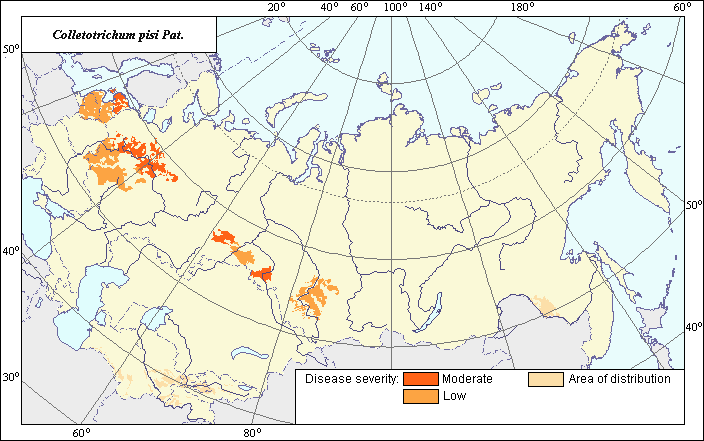Diseases
Distribution and severity zones of Anthracnose of Peas (Colletotrichum pisi Pat.)
 Object description Download GIS-layers
Object description Download GIS-layers
Authors.
Specialist-biologist - Kungurtseva O.V.,GIS-specialist - Saulich M.I.
Date of creation.
15. 11. 2004.Scale.
1:20 000 000.Accuracy of map:
Map was created based on information taken from open-published literature and maps of scale 1: 33 000 000.Projection:
"Alber's Equal Area Conic for the USSR", 9, 1001, 7, 100, 0, 44, 68, 0, 0.Basic contents:
Vector map. Area of species distribution and zones of disease severity are shown by polygons.Accuracy of classifier:
The zone of moderate disease severity of Anthracnose of Peas was determined based on the published materials listed below. Cool and damp summers are typical for that zone and disease development can reach 10-25% during favorable years. The zone of low severity represents territories with only individual exhibitions of the disease.Method of map production:
Scientists were given maps with boundaries of Oblasts and arable lands. After reviewing historic literature, species distribution was hand drawn on maps. If data were on the Oblast-level, distribution is on the Oblast level. In some cases, Oblast.s are further refined by boundaries of the Arable Land Map (Koroljeva et al., 2003). Hand drawn maps were scanned, georeferenced and vectorized. The following sources demonstrate that within the territory of the former USSR, Anthracnose of Pea is found in the Baltic States, Non-Chernozem zone, Western Siberia, Ural, Amur Region, and Central Asia: Vasilevskii & Karakulin (1950), Antonova (1940), Vasilevskii et al. (1950), Makasheva (1973). Based on the analysis of the following publications, the zone of moderate severity was determined to cover the north Non-Chernozem zone, Omsk, Sverdlovsk Regions, Estonia: Mikhailenko (1971), Kotova et al. (1965), Starostin et al. (1988). In the zone of low severity the centers of insignificant development of the disease were marked.Reference citations:
Antonova R.P. 1940. Anthracnose of Peas. Vestnik selskokhozyaistvennoi nauki, Ovoshchevodstvo i kartofel (Moscow: Selkhozgiz), 5: 51-55. (In Russian)Koroljeva IE, Vilchevskaya EV, Ruhovich DI. 2003. Digital Arable Land Map. Laboratory of Soil Information of the Dokuchaev Soil Institute, Moscow, Russia [Based on: Yanvareva LF. (ed.), Martynjuk KN., Kisileva NM. 1989. Map of Land Use, Faculty of Geography, Moscow State University, Moscow, Russia.].
Kotova V.V., Khaleeva Z.N., Shekunova E.G. 1965. Fungal diseases of leguminous cultures. In: Polyakov I.Ya., Chumakov A.E., eds. Proc. VIZR. V. 25. Leningrad: Kolos. 159-164 p. (In Russian)
Makasheva R.Kh. 1973. The pea. Leningrad: Kolos. 312 p. (In Russian)
Mikhailenko M.A. 1971. Peas in West Siberia. Omsk: West Siberian Publishing House. 283 p. (In Russian)
Starostin S.P., Kotova V.V., Tsvetkova N.A., Borisenko L.A. 1988. Pests, diseases and weeds on peas and their control. Zashchita rastenii, 3: 14-15. (In Russian)
Vasil'evskii N.I., Karakulin B.P. 1950. Parasitic imperfect fungi. Part 2. Melanconiaceae. Moscow-Leningrad: AN SSSR. 680 p. (In Russian)

